
While the government has benefited from surging iron ore prices and Mathias Cormann’s restraint on spending in getting the budget back to surplus, it’s about to get another fiscal win — on bond prices.
Government debt for triple-A-rated economies like Australia’s is currently remarkably cheap on global markets. The yield on Australia’s 10-year bond yield is now just 1.08%, the lowest on record. But Australian bonds are being chased by anxious buyers because our bonds still trade at a positive yield, unlike trillions of dollars worth of bonds in Europe and Japan.
The entire US$5.4 trillion of German government debt is now trading at negative yields, meaning the holders of those bonds are in effect paying the German government for its bonds, instead of receiving regular interest payments. The 10-year Bund yield, for example, is -0.5%. It’s the same or similar across a number of other economies.
As of Friday, yields on 10-year bonds issued by the Netherlands were 0.39%, Switzerland -0.88%, and France -0.24%. For Japan, where negative yields are now a part of everyday life, the 10-year yield is -0.10%. Ahead of Brexit, the UK’s 10-year bond yield is 1.55%; for the US, the yield is 1.86%.
European bond yields have been driven lower by a combination of the very easy monetary policy of the European Central Bank with its key interest rate (like the RBA’s cash rate) at -0.4%. The Bank of Japan and the Bank of Switzerland also have negative indicator rates.
Here, other Australian government bond yields are also at all-time lows: 0.78% for the two-year security, 0.77% for five-year bonds and 1.33% for 30-year bonds. But Australia only has one bond line falling due this year — $14.93 billion on October 21. It carries a coupon rate of 2.75%, so a refinancing of that line at around 1.10% would see more than a halving in the annual interest cost of around $403 million a year to around $160-$170 million.
That would reduce the cost of additional infrastructure investment — or perhaps make a deposit on boosting Newstart, should the pressure to lift it prove overwhelming.
A further $40.8 billion in two bond lines fall due in April and November next year. The April issue of $19.3 billion carries a very expensive coupon of 4.75% (or $920 million a year). Refinancing that at current rates or lower in 2020 would see the cost fall to less than $200 million — a major saving.
This is a very good time for a government to be a borrower.








Crikey is committed to hosting lively discussions. Help us keep the conversation useful, interesting and welcoming. We aim to publish comments quickly in the interest of promoting robust conversation, but we’re a small team and we deploy filters to protect against legal risk. Occasionally your comment may be held up while we review, but we’re working as fast as we can to keep the conversation rolling.
The Crikey comment section is members-only content. Please subscribe to leave a comment.
The Crikey comment section is members-only content. Please login to leave a comment.